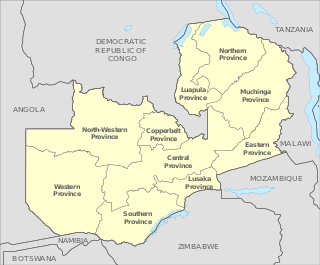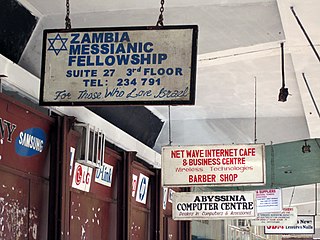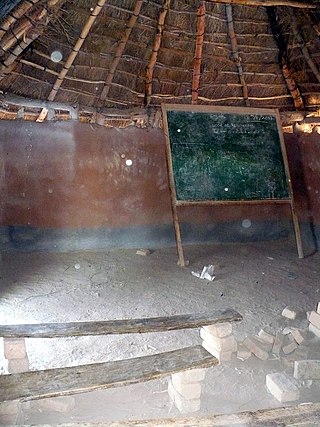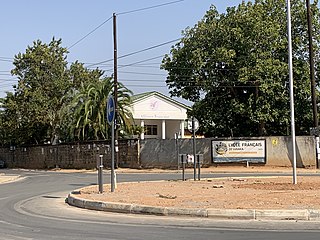Related Research Articles

Zambia is divided into 10 provinces for administrative purposes. Each province is headed by a minister appointed by the President and there are ministries of central government for each province. The administrative head of each province is the Permanent Secretary, appointed by the President. There are Deputy Permanent Secretary, heads of government departments and civil servants at the provincial level.

Ndola is the third largest city in Zambia and third in terms of size and population, with a population of 475,194, after the capital, Lusaka, and Kitwe, and the second largest in terms of infrastructure development after Lusaka. It is the industrial and commercial center of the Copperbelt, Zambia's copper-mining region, and capital of Copperbelt Province. It lies just 10 kilometres (6.2 mi) from the border with DR Congo. It is also home to Zambia's first modern stadium, the Levy Mwanawasa Stadium.

Chipata is a city and administrative centre of the Eastern Province of Zambia and Chipata District. It was declared the 5th city of the country, after Lusaka, Ndola, Kitwe and Livingstone, by President Edgar Lungu on 24 February 2017. The city has undergone rapid economic and infrastructure growth in the years, leading up to city status.

Kitwe is the third largest city in terms of infrastructure development and second largest city in terms of size and population in Zambia. With a population of 517,543 Kitwe is one of the most developed commercial and industrial areas in the nation, alongside Ndola and Lusaka. It has a complex of mines on its north-western and western edges.

Mazabuka is a town in the Southern Province of Zambia. It is the capital of Mazabuka District, one of the thirteen administrative units in the Southern Province.

Choma is a town that serves as the capital of the Southern Province of Zambia. It is also the capital of Choma District, one of the 15 administrative districts in the province.

Lusaka Province is one of the ten provinces of Zambia. Its capital is Lusaka, which is also the national capital. It is the smallest province in Zambia, with an area of 21,896 km2. Lusaka is also Zambia's most populated and most densely populated province, with a population of 2,191,225 and density of 100 persons per km2 as of 2010. It is the most urban province, with the most doctors and fewest malaria-related incidents. The province is bordered by Zimbabwe and Mozambique, and separated by the Lower Zambezi National Park.

Southern Province is one of Zambia's ten provinces, and home to Zambia's premier tourist attraction, Mosi-oa-Tunya, shared with Zimbabwe. The centre of the province, the Southern Plateau, has the largest area of commercial farmland of any Zambian province, and produces most of the maize crop.
Sound Seekers was a British charity which works to improve the lives of deaf children and children with ear diseases in the developing countries of the Commonwealth of Nations. It provided specialist equipment, training and support to some of the poorest countries of the world, where people with the 'hidden disability' of deafness may otherwise not receive the help they need. In 2020, Sound Seekers merged with DeafKidz International, with the combined charity using the DeafKidz International name.

Zambia has several major indigenous languages, all members of the Bantu family, as well as Khwedam, Zambian Sign Language, several immigrant languages and the pidgins Settla and Fanagalo. English is the official language and the major language of business and education.

Lower education in Zambia is divided into three levels and these are namely: primary, junior secondary and upper secondary. Higher education in Zambia has improved in the recent years due to the increase of private universities and colleges. The biggest university is the public University of Zambia which is located in the capital city of Lusaka along the great east road and hosts a number of local and international students. The Copperbelt University is the second largest public university and is located in the Copperbelt province of Zambia in Kitwe, and the youngest public university is Mulungushi University, with its main campus 26 km north of Kabwe. There are many other smaller universities, both public and private including the following: Texila American University, Zambia Open University, European University Zambia Zambia Catholic University, Cavendish University, Zambia Adventist University, Northrise University, University of Lusaka, Lusaka Apex Medical University, Woodlands University College, Copperstone University College, University of Barotseland, University of Africa, Information and Communication University, Kwame Nkrumah University of Education, Chalimbana University, Rusangu University, Robert Makasa University, Zambia Centre of Accountancy Studies and there are various Health training Institutes offering Diplomas in clinical medicine Registered Nursing

Lusaka is the capital and largest city of Zambia. It is one of the fastest-developing cities in southern Africa. Lusaka is in the southern part of the central plateau at an elevation of about 1,279 metres (4,196 ft). As of 2019, the city's population was about 3.3 million, while the urban population is estimated at 2.5 million in 2018. Lusaka is the centre of both commerce and government in Zambia and connects to the country's four main highways heading north, south, east, and west. English is the official language of the city administration, while Bemba, Tonga, Lenje, Soli, Lozi, and Nyanja are the commonly spoken street languages.
Lazarus Tembo was one of Zambia's most popular singers. He was born in the Eastern Province of Zambia, went blind at the age of eight, and eventually, under President Kaunda, became Zambia's Junior Minister of Culture.

Access Bank Zambia, whose full name is Access Bank Zambia Limited, is a commercial bank in Zambia. It is licensed by the Bank of Zambia, the central bank and national banking regulator.
In recent decades, the population of Chinese people in Zambia has rapidly increased. There were 80,000 Chinese people living in Zambia according to a 2019 U.N. World Population study.

French School of Lusaka is a French international school on the property of the Alliance française campus in Longacres, Lusaka, Zambia. The Embassy of France in Zambia and French families campaigned to have the school established; it opened in 1980 and moved to its current site in September 2005. The school serves preschool through CM2, and using the National Centre for Distance Education (CNED) distance education programme it also serves collège and lycée until terminale.
Chimwemwe Chihana, also known by her married name Chimwemwe Chihana Mtawali, is a Zambian photographer known as Qcheda. She is also a Digital Media Specialist, and has written and performed Afro-pop, reggae and dancehall songs under her stage name Wacheda.

The T2 is a trunk road in Zambia. The road runs from the Tunduma border with Tanzania via Mpika, Kabwe and Lusaka to the Chirundu border with Zimbabwe. The road is the longest route of the country, as it is approximately 1,155 kilometres (718 mi). The route from Mpika to Kafue is a toll road. The route from Tanzania to Lusaka is Zambia's Great North Road and is part of the Tanzam Highway.

First Capital Bank Zambia Limited, is a commercial bank in Zambia that is licensed by the Bank of Zambia, the central bank and national banking regulator. It is a subsidiary of FMBCapital Holdings Plc, a financial services conglomerate, based in Mauritius, whose shares of stock are listed on the Malawi Stock Exchange and has subsidiaries in Botswana, Malawi, Mozambique, Zambia and Zimbabwe.
Chreso University (CU) is a non-profit private higher-education institution located in the urban setting of the metropolis of Lusaka, Zambia. Established in 2010, this institution also has a branch campus in Ndola. Officially recognized by the Ministry of Higher Education of Zambia, Chreso University (CU) is a small coeducational Zambian higher education institution. Chreso University offers courses and programs leading to officially recognized higher education degrees such as pre-bachelor's degrees, bachelor's degrees, master's degrees, doctorate degrees in several areas of study. This institution has a selective admission policy based on students' past academic records. The admission rate range is 50-60% making this Zambian higher education organization a averagely selective institution. International applicants are eligible to apply for enrollment. CU also provides several academic and non-academic facilities and services to students including a library, housing, sports facilities, financial aids and/or scholarships, study abroad and exchange programs, online courses and distance learning opportunities, as well as administrative services.